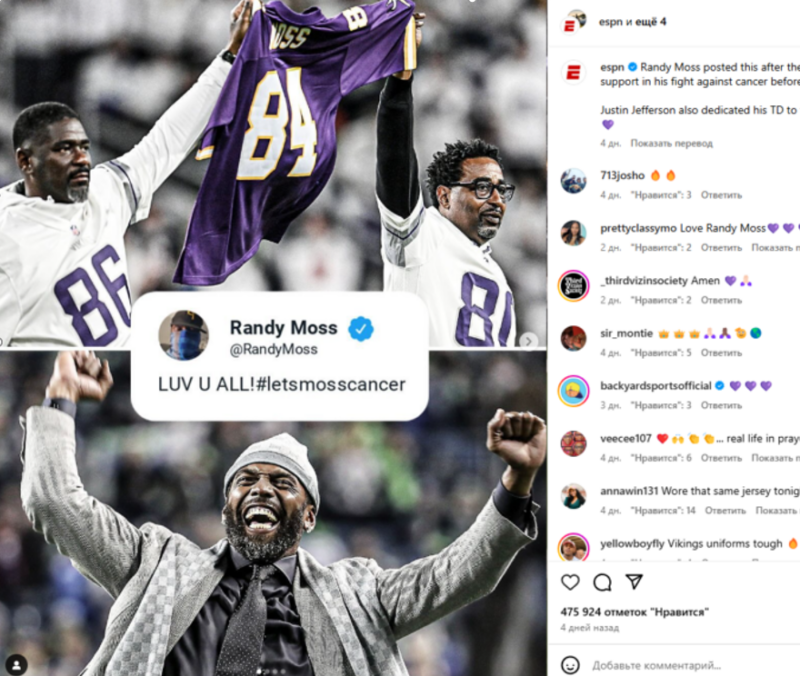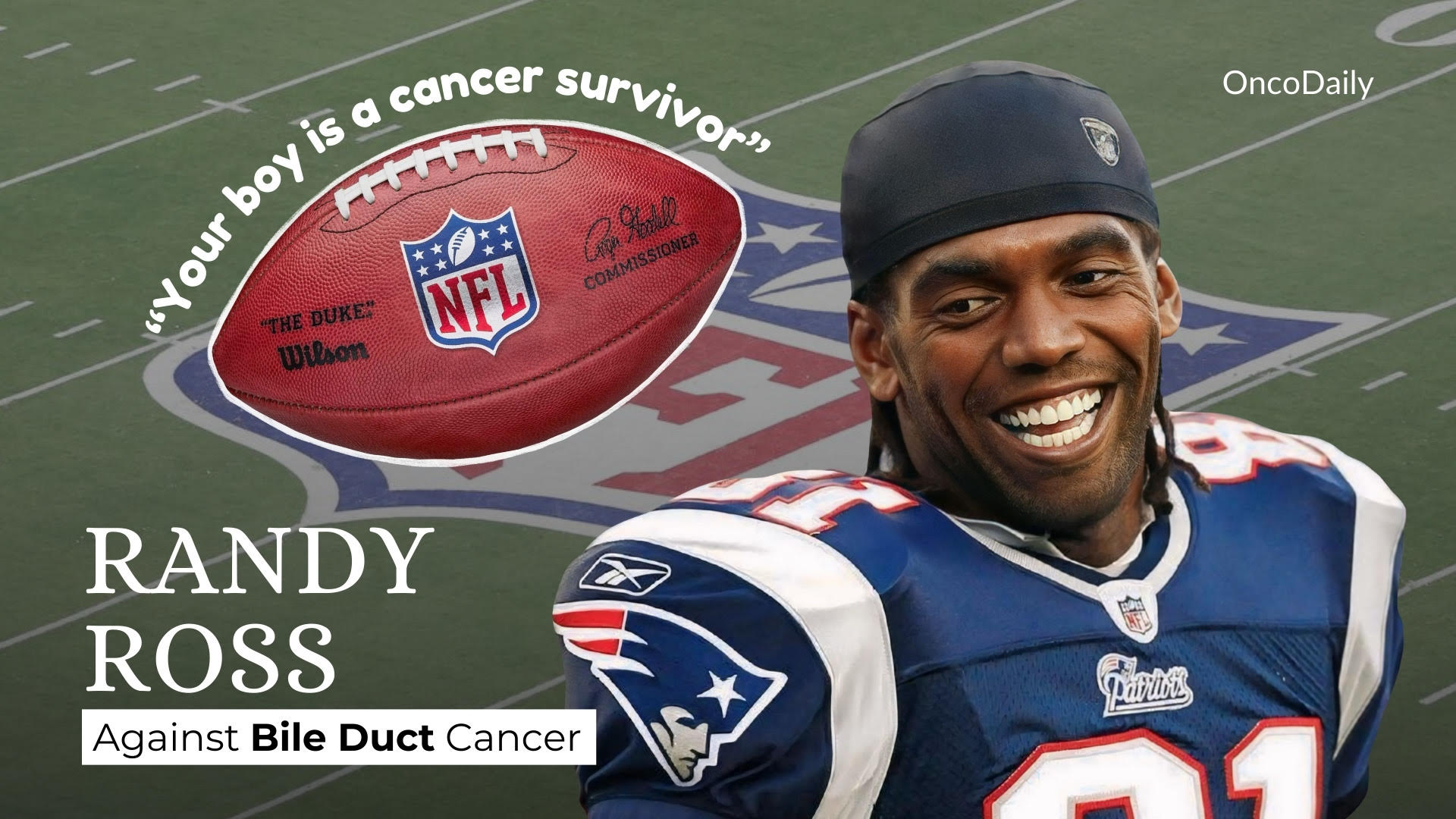Randy Moss is a former professional American football wide receiver, widely regarded as one of the greatest in NFL history. Over his 14-season career, he played for teams including the Minnesota Vikings, Oakland Raiders, New England Patriots, Tennessee Titans, and San Francisco 49ers. Known for his exceptional speed and leaping ability, he was a key player in two of the highest-scoring offenses in NFL history and was inducted into the Pro Football Hall of Fame in 2018.
During an Instagram Live session on December 13, 2024, Moss shared that doctors discovered cancer in his bile duct also known us cholangiocarcinoma, located between his pancreas and liver. He described the cancer as being situated just outside the bile duct. Moss underwent a Whipple procedure, a complex surgical operation and following his surgery, Moss announced that he would undergo additional treatments, including chemotherapy and radiation therapy, as part of his ongoing battle against cancer. Beyond his health struggle, the article also delves into Randy Moss’s legendary career achievements, highlighting his iconic roles in the NFL, It also reveals his retiring from professional football, Moss transitioned into broadcasting as an analyst for ESPN.

How did Randy Moss Start his Legendary Career?
Born on February 13, 1977, in Rand, West Virginia, Randy Moss was a standout athlete in high school, excelling in both football and basketball. His path to the NFL, however, faced setbacks. After high school, Moss initially committed to Notre Dame but lost the scholarship due to a racially charged incident. He then transferred to Florida State University but was dismissed after testing positive for marijuana. Despite these challenges, his talent was undeniable, and he transferred to Marshall University.
At Marshall, Moss became one of the most dominant wide receivers in college football, recording 174 receptions for 3,529 yards and 54 touchdowns in two seasons. His play helped lead Marshall to an undefeated season and a national championship in 1996. Moss declared for the NFL Draft after his junior year and was selected 21st overall by the Minnesota Vikings in 1998.
In his rookie season, Moss set records with 17 touchdown receptions, earning NFL Offensive Rookie of the Year honors. Known for his explosive speed, athleticism, and playmaking ability, Moss quickly became one of the NFL’s most exciting and feared receivers, solidifying his place as a legendary figure in the sport.
What were the Highest Wins and Successes of Randy Moss’s Career?
Randy Moss’s career is marked by several significant achievements and milestones that highlight his success as one of the greatest wide receivers in NFL history. In his 1998 rookie season, Moss made an immediate impact with the Minnesota Vikings, setting a rookie record for touchdown receptions with 17 and recording 1,313 receiving yards, which earned him the NFL Offensive Rookie of the Year award. His remarkable performances helped the Vikings achieve a stellar 15-1 record that season.
Moss continued to excel in 2007 while playing for the New England Patriots, where he had one of the most remarkable seasons in NFL history. He set the single-season record for touchdown receptions with 23, contributing to the Patriots’ perfect regular-season record of 16-0. The team scored a total of 589 points, making it one of the highest-scoring offenses in NFL history.
Throughout his career, Moss was selected to the Pro Bowl a total of six times and was named a First-Team All-Pro four times, consistently ranking among the league leaders in receiving yards and touchdowns. At the time of his retirement, he ranked second all-time in career touchdown receptions with 156 and third in total receiving yards with over 15,292, known for his explosive plays and ability to make contested catches.

Randy Moss and his Hall of Fame gold jacket spent part of Sunday in his native West Virginia. (AP)
From NFL Superstar to Sports Analyst and Community Leader
Moss played in two Super Bowls: Super Bowl XLII with the New England Patriots and Super Bowl XLVII with the San Francisco 49ers. Although he did not win a championship, his performances in these games were notable and contributed to his legacy.In recognition of his outstanding career, Randy Moss was inducted into the Pro Football Hall of Fame in 2018, further solidifying his legacy as one of the all-time greats in football history.
Randy Moss’s career beyond sports reflects his multifaceted life as he transitioned from an NFL superstar to a prominent figure in broadcasting and community involvement. After retiring from professional football, Moss took on a role as an analyst for ESPN, where he showcased his deep understanding of the game and provided insightful commentary. His engaging personality and candid opinions have made him a respected voice in sports media.In addition to his broadcasting career, Moss has been actively involved in youth sports, serving as an assistant high school coach in Charlotte, North Carolina, where his son plays. This role allows him to share his extensive knowledge of the game with young athletes and contribute positively to their development.
How Did Randy Moss Get Diagnosed with Bile Duct Cancer?
Randy Moss discovered his bile duct cancer after experiencing symptoms such as discolored urine, which prompted him to seek medical attention. During an Instagram Live session, he explained that it was “by divine intervention” that he noticed these changes in his body, leading to further examinations. Initially, he underwent a procedure to insert a stent into his liver, which allowed doctors to investigate the underlying issues. This series of events ultimately led to the diagnosis of cancer located between his pancreas and liver.
Randy Moss has been diagnosed with bile duct cancer,also known as cholangiocarcinoma, is a rare and aggressive form of cancer that affects the bile ducts, which are the tubes that carry bile from the liver to the small intestine. He revealed this diagnosis during an Instagram Live session, stating that doctors discovered the cancer “right outside the bile duct.”
Does Randy Moss Have Any Symptoms of Bile Duct Cancer?
Prior to his surgery, Moss experienced symptoms that prompted medical attention. He mentioned having discolored urine, which led to the insertion of a stent in his liver on Thanksgiving. After spending six days in the hospital following his surgery, he expressed gratitude for the support he received from fans and medical professionals. Bile duct cancer may not cause symptoms in its early stages, making early detection challenging. When symptoms do occur, they can include
- Jaundice: Yellowing of the skin and the whites of the eyes due to a buildup of bilirubin in the bloodstream.
- Changes in Urine and Stool Color: Dark urine and pale or greasy stools can occur when bile flow is obstructed.
- Itchy Skin: Elevated bilirubin levels can cause itching.
- Abdominal Pain: Pain is often felt on the right side of the abdomen, especially below the ribs.
- Fever and Chills: A high temperature may indicate inflammation or infection.
What was the Prognosis?
Randy Moss’s cancer was diagnosed as bile duct cancer, specifically a tumor located outside the bile duct between his pancreas and liver. Although he did not specify the exact stage of his cancer, the fact that he underwent a Whipple procedure—a complex surgery typically performed to remove tumors in the bile duct and pancreas—suggests that his diagnosis was likely at an early stage.
The 5-year survival rate for bile duct cancer (cholangiocarcinoma) is generally low, ranging from 10-30%, depending on the stage at diagnosis. Early detection significantly improves survival chances, with patients diagnosed in the early stages having a better prognosis (American Cancer Society, 2020). However, the prognosis worsens significantly if the cancer is diagnosed at later stages, such as Stage III or Stage IV, due to the cancer’s tendency to spread quickly to nearby tissues and distant organs (National Cancer Institute, 2020)
What Treatment Did Randy Moss Undergo for Bile Duct Cancer?
Randy Moss underwent a Whipple procedure also known as pancreaticoduodenectomy to treat his bile duct cancer. This complex surgery, which lasted six hours, involved the removal of several structures, including the head of the pancreas, part of the small intestine, the gallbladder, and the bile duct. The surgery was performed after doctors discovered a cancerous mass during a prior procedure where a stent was placed in his liver due to discolored urine. Following the Whipple procedure, Moss spent six days in the hospital and has since been declared cancer-free. He is now undergoing additional treatment, which includes chemotherapy and radiation therapy, as part of his recovery process.
Moss has expressed gratitude for the support from his medical team, family, and fans throughout this challenging time, highlighting his determination to overcome the illness and return to his broadcasting duties at ESPN when he is able.
More about the Whipple Procedure
The Whipple procedure aims to remove tumors located in the head of the pancreas and surrounding structures, including parts of the bile duct and small intestine. It is often performed for conditions such as pancreatic cancer, bile duct cancer (cholangiocarcinoma), and other tumors affecting the pancreas or duodenum. After removing these structures, the surgeon reconnects the remaining parts of the digestive system to allow food to pass through. This includes reconnecting the pancreas to the small intestine (jejunum) and rejoining the bile duct.
- Standard Whipple Procedure: Involves removing all mentioned structures.
- Pylorus-Preserving Whipple: A modified version that retains the pylorus (the valve at the bottom of the stomach), which can help with gastric function post-surgery.
The procedure typically takes about 5 to 8 hours, depending on various factors, including the complexity of the case and surgical technique used. Patients usually remain in the hospital for about one to two weeks following surgery, depending on their recovery progress. The Whipple procedure can significantly improve survival rates for patients with resectable pancreatic cancer, especially if performed early in the disease’s progression. However, its effectiveness depends on various factors, including tumor size, location, and whether cancer has spread to other organs.
How Did Randy Moss Overcome His Cancer Diagnosis?
Throughout this journey, Moss has balanced his health challenges with his family life and public persona. He emphasized the importance of family, stating that he is surrounded by loved ones who have been his “prayer warriors” during this difficult time. Moss shared that he never expected to find himself in such a situation, reflecting on his previous belief in his good health:
“I didn’t think I would ever be in this position, as healthy as I thought I was.”
His commitment to raising awareness about cancer screenings is evident in his public appearances and messages. Moss has urged others to prioritize their health, particularly high-risk groups like Black men, by advocating for regular check-ups. He stated, “Get your stuff checked,” reinforcing the importance of early detection.
Support from Family
After announcing his diagnosis and undergoing a Whipple procedure, Moss expressed deep gratitude for the encouragement and prayers from his loved ones, which include his wife, Lydia Moss, and their children, including their daughter Lordes-Randi, as well as his other children from previous relationships. During an Instagram Live session, Moss emphasized the importance of family in his recovery journey, stating,
“I’m surrounded by my family.”

He referred to them as his “prayer warriors,” highlighting how their emotional and spiritual support has been crucial during this challenging time. Moss acknowledged that he never expected to find himself in such a situation, especially considering his previous belief in his good health. He credited his family and friends for being there for him and helping him navigate through this difficult period.His son, Thaddeus Moss, has also been actively involved in supporting him, sharing updates on social media and expressing concern for his father’s health. The family’s unity and collective strength have played a vital role in helping Randy Moss cope with the challenges posed by his illness.
Support from NFL Community
The NFL community has rallied around Randy Moss following his diagnosis of bile duct cancer, demonstrating the strong bonds formed during his illustrious career. Notable figures such as Julian Edelman and Rob Gronkowski expressed their support on social media, with Edelman referring to Moss as “mental toughness in human form,” while Gronkowski encouraged him by saying, “You got this!” These messages reflect the camaraderie and respect Moss has earned throughout his time in the league.The Minnesota Vikings, the team where Moss spent a significant portion of his career, publicly supported him as well. Head coach Kevin O’Connell conveyed the team’s well wishes, stating,
“We love Randy and know our fanbase feels the same way.”

During a recent game against the Chicago Bears, former Vikings legends Cris Carter and Jake Reed honored Moss by carrying his iconic number 84 jersey during the coin toss, which elicited cheers from the crowd. Additionally, current Vikings star receiver Justin Jefferson dedicated a touchdown to Moss, saying on camera, “We love you, Randy!” This sentiment resonated deeply with fans and highlighted the lasting impact Moss has had on the franchise.Fans have also rallied around Moss, expressing their admiration and support through social media platforms. The outpouring of love from both players and fans underscores the unity within the NFL community during this challenging time for Moss.
Emotional Return to ESPN’s “Sunday NFL Countdown”
Randy Moss made an emotional return to ESPN’s “Sunday NFL Countdown” on February 9, 2025, for Super Bowl LIX coverage, after stepping away in December for cancer treatment ESPN welcomed him back with a heartfelt video featuring messages from figures like Tom Brady and Bill Belichick. Moss was moved to tears by the video tribute. He expressed his gratitude and shared that he was thrilled to be back. Moss had revealed that he underwent surgery to remove a cancerous mass in his bile duct.
Kendrick Lamar electrified the Super Bowl LIX halftime show in New Orleans on February 9, 2025. Introduced by Samuel L. Jackson, Lamar delivered a high-energy performance, showcasing his lyrical prowess and stage presence. SZA made a special guest appearance, adding another layer of excitement to the unforgettable show.
What Causes Bile Duct Cancer ?
Bile duct cancer, or cholangiocarcinoma, is a rare and aggressive cancer affecting the bile ducts, which transport bile from the liver to the gallbladder and small intestine. While the exact cause of bile duct cancer is not fully understood, several known risk factors contribute to its development.
Chronic inflammation of the bile ducts is a significant factor, often caused by conditions like primary sclerosing cholangitis (PSC). PSC leads to inflammation and scarring of the bile ducts, significantly increasing the risk of cholangiocarcinoma, particularly in individuals with inflammatory bowel disease (IBD), such as ulcerative colitis (Chapman et al., 2010). Another notable risk is liver fluke infections, especially in Southeast Asia, where parasites like Opisthorchis viverrini and Clonorchis sinensis cause chronic irritation and scarring in the bile ducts, potentially leading to cancer (Sripa et al., 2011).
Cirrhosis of the liver, resulting from chronic liver diseases like hepatitis B or C, also increases the risk of bile duct cancer. Chronic liver damage can alter the structure of the bile ducts, making them more susceptible to cancer (El-Serag, 2011). Additionally, congenital abnormalities such as biliary atresia or Caroli disease that impair bile flow or cause bile duct malformation are linked to a higher risk of cholangiocarcinoma due to long-term irritation and inflammation in the bile ducts (Russo et al., 2005).Genetic factors play a role as well.
Inherited conditions such as Lynch syndrome, which increases the risk of multiple cancers, and cystic fibrosis, which can lead to liver disease and biliary tract abnormalities, are associated with a higher likelihood of developing bile duct cancer (Witzigmann et al., 2017). Age is another significant factor; the highest incidence of cholangiocarcinoma occurs in individuals over 65 years old. Certain ethnic groups, including Hispanic Americans in the U.S. and populations in Southeast Asia, experience higher rates of bile duct cancer (Banales et al., 2016).
Lifestyle factors such as obesity and diabetes are also linked to an increased risk of developing cholangiocarcinoma. These conditions contribute to chronic inflammation and metabolic disturbances that can heighten cancer susceptibility (Zhu et al., 2017).While not everyone with these risk factors will develop cholangiocarcinoma, and some individuals without known risk factors may still be diagnosed, understanding these factors is crucial for early detection and prevention. Ongoing research continues to investigate the mechanisms behind bile duct cancer and potential preventive measures, offering hope for better treatment strategies in the future.
Chemotherapy and Radiotherapy for Bile Duct Cancer
Chemotherapy and radiotherapy are important treatment options for bile duct cancer, also known as cholangiocarcinoma. Chemotherapy involves the use of anti-cancer drugs to destroy cancer cells or inhibit their growth and is typically used in several scenarios for bile duct cancer.
After surgery, chemotherapy may be administered as adjuvant therapy to reduce the risk of recurrence. This treatment usually involves about eight cycles of chemotherapy with capecitabine tablets over approximately 6 months. In some cases, chemotherapy may be given before surgery (neoadjuvant chemotherapy) to shrink tumors, making them easier to remove successfully. For advanced cancer that is unresectable (cannot be surgically removed) or has metastasized, chemotherapy can help control the disease and alleviate symptoms. Common chemotherapy regimens include combinations such as gemcitabine and cisplatin or FOLFOX (which includes fluorouracil and oxaliplatin). For patients with advanced disease, chemotherapy may be used in palliative care to relieve symptoms and improve quality of life rather than cure the cancer.
The most commonly used chemotherapy drugs for bile duct cancer include capecitabine, gemcitabine, cisplatin, oxaliplatin, and combination therapies like FOLFOX. While chemotherapy can significantly help manage bile duct cancer, it may also cause side effects such as nausea, fatigue, hair loss, and increased risk of infection. Most side effects are manageable and typically resolve after treatment ends.
Radiotherapy uses high-energy rays to kill cancer cells and is not commonly used as a primary treatment for bile duct cancer but can be beneficial in certain situations. It may be employed post-surgery to help prevent recurrence in high-risk patients or to control symptoms in advanced stages of the disease by shrinking tumors that cause pain or obstruct bile flow.
Sometimes, radiotherapy is combined with chemotherapy (chemoradiotherapy) to enhance treatment effectiveness.
In summary, chemotherapy and radiotherapy play crucial roles in the management of bile duct cancer, particularly for patients who cannot undergo surgery or have advanced disease. While they can significantly improve outcomes and quality of life, discussions with healthcare providers about potential benefits and side effects are essential for informed decision-making regarding treatment options.
Targeted therapy for bile duct cancer, also known as cholangiocarcinoma, is an emerging treatment approach that focuses on specific molecular targets associated with cancer cell growth and survival. This strategy aims to improve outcomes for patients, particularly those with advanced disease who may not respond well to traditional chemotherapy.
Overview of Targeted Therapy for Bile Duct Cancer
Targeted therapies utilize drugs or other substances to identify and attack specific cancer cells while minimizing damage to healthy cells. These therapies often focus on genetic mutations or alterations present in the cancer cells.
Types of Targeted Therapies:
-
- TRK Inhibitors: Medications like larotrectinib and entrectinib target NTRK gene fusions found in some bile duct cancers, leading to abnormal protein production that promotes cancer growth.
- BRAF and MEK Inhibitors: For cancers with the BRAF V600E mutation, a combination of dabrafenib (a BRAF inhibitor) and trametinib (a MEK inhibitor) can be effective in treating advanced disease.
- FGFR Inhibitors: Drugs such as pemigatinib target fibroblast growth factor receptor (FGFR) alterations, showing promise in improving survival rates for patients with specific genetic profiles.
Studies indicate that targeted therapies can lead to improved survival rates compared to traditional chemotherapy. For instance, patients receiving targeted therapy had an overall survival rate of approximately 22.3 months, compared to 17.5 months for those treated with standard chemotherapy regimens.
How Can Bile Duct Cancer Be Prevented?
To reduce the risk of bile duct cancer, several preventive measures can be taken, particularly focusing on maintaining a healthy lifestyle and regular medical check-ups.
Regular Health Screenings
Regular screenings and check-ups are crucial for early detection of bile duct cancer, especially for high-risk groups like those with chronic liver diseases, primary sclerosing cholangitis (PSC), or a family history of cancer. Since bile duct cancer often goes undetected in its early stages, routine physical exams are not enough for diagnosis. There are no standardized screening tests, so many cases are diagnosed only after symptoms like jaundice or abdominal pain appear. For those at higher risk, proactive health management with regular check-ups and specific tests is essential for early detection, improving treatment outcomes. By staying vigilant and discussing risk factors with healthcare providers, patients can increase their chances of catching the disease early when it’s more treatable.
Lifestyle Changes
To reduce the risk of bile duct cancer, several lifestyle changes can be beneficial. Adopting a balanced diet rich in fruits, vegetables, and whole grains, while limiting processed foods, red meats, and sugary drinks, is key. Increasing fiber intake can also help lower the risk of gallstones, which are linked to bile duct cancer. Regular exercise is crucial for maintaining a healthy weight and overall health, and it can reduce the risk of various cancers. Limiting alcohol consumption is important, as excessive intake can cause liver damage and increase cancer risk.
The American Cancer Society recommends no more than one drink per day for women and two for men. Quitting smoking is essential, as tobacco use is linked to increased cancer risk, including biliary tract cancers. Lastly, maintaining a healthy weight is vital, as obesity is a major risk factor for bile duct cancer.
Written By Aharon Tsaturyan, MD
FAQs
What type of cancer was Randy Moss diagnosed with?
Randy Moss was diagnosed with bile duct cancer, which was located between his pancreas and liver.
What symptoms did Randy Moss experience before his diagnosis?
Moss experienced symptoms such as discolored urine and liver malfunction, which prompted him to seek medical attention and ultimately led to his diagnosis.
What treatment did Randy Moss undergo for his cancer?
Moss underwent a Whipple procedure, a complex surgery to remove the tumor, and is currently undergoing chemotherapy and radiation as part of his recovery plan.
How has Randy Moss described his experience with cancer?
Moss has referred to himself as a “cancer survivor” and expressed gratitude for the support he received from family, friends, and fans during this challenging time.
What is the prognosis for Randy Moss’s cancer?
The chance of Randy Moss’s cancer returning is estimated to be between 60% and 65%, according to medical experts, but factors such as his age and overall health may positively influence his treatment outcomes.
What message has Randy Moss shared regarding health screenings?
Moss has emphasized the importance of regular health check-ups and early detection, urging others to prioritize their health and not ignore symptoms, particularly for high-risk groups like Black men.
What teams did Randy Moss play for during his NFL career?
Randy Moss played for several teams throughout his 14-season NFL career, including the Minnesota Vikings, Oakland Raiders, New England Patriots, Tennessee Titans, and San Francisco 49ers. He is widely regarded as one of the greatest wide receivers of all time.
What are Randy Moss’s career achievements and records?
Moss holds numerous records, including the NFL single-season touchdown reception record with 23 touchdowns in 2007 and the record for most touchdown receptions by a rookie with 17 in 1998. He ranks second in career touchdown receptions and fourth in career receiving yards. Moss was inducted into the Pro Football Hall of Fame in 2018 and is a member of the NFL 2000s All-Decade Team.
How do NFL playoffs work?
The NFL playoffs consist of a single-elimination tournament held after the regular season, culminating in the Super Bowl. A total of 14 teams qualify for the playoffs: seven from the AFC and seven from the NFC. The playoffs include Wild Card games, Divisional rounds, Conference Championships, and ultimately, the Super Bowl.
What is the history of the Super Bowl?
The Super Bowl is the annual championship game of the NFL, first played in 1967 as part of the merger agreement between the NFL and AFL. It has grown into one of the biggest sporting events in the world, featuring elaborate halftime shows and attracting millions of viewers.
Written By Aharon Tsaturyan, MD
